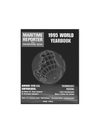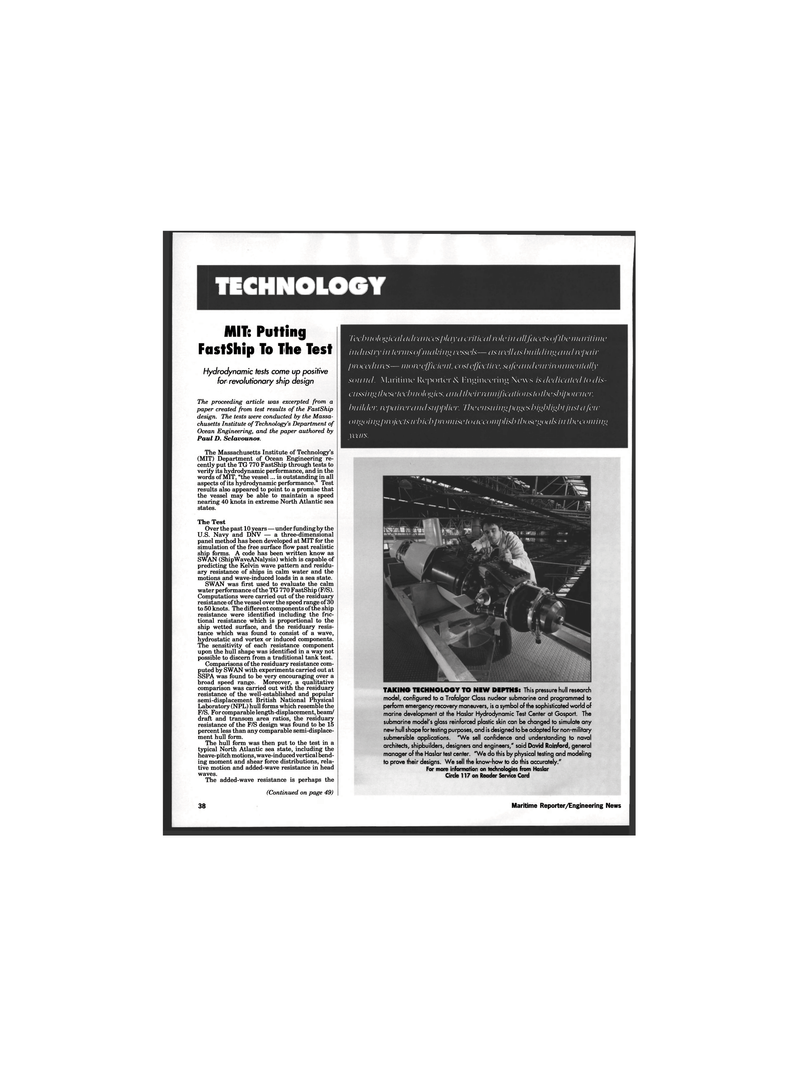
Page 36: of Maritime Reporter Magazine (June 1995)
Read this page in Pdf, Flash or Html5 edition of June 1995 Maritime Reporter Magazine
TECHNOLOGY
Technological atlrauces play a critical role in allJdcelsof the maritime industry in terms i>fma king ressels—as well as building and'repair procedures— moreefficient. cost effect ire, safe and em iron mortally sound. Maritime Reporter & Engineering New s is dedicated to dis- cussing these technologies. and their ramifications to theshipowner. builder, repairerand supplier. The ensuing pages highlightjust aJew ongoiugprojects which pronuse to accomplish those goals in {becoming n'ais.
MIT: Putting
FastShip To The Test
Hydrodynamic tests come up positive for revolutionary ship design
The proceeding article was excerpted from a paper created from test results of the FastShip design. The tests were conducted by the Massa- chusetts Institute of Technology's Department of
Ocean Engineering, and the paper authored by
Paul D. Sclavounos.
The Massachusetts Institute of Technology's (MIT) Department of Ocean Engineering re- cently put the TG 770 FastShip through tests to verify its hydrodynamic performance, and in the words of MIT, "the vessel... is outstanding in all aspects of its hydrodynamic performance." Test results also appeared to point to a promise that the vessel may be able to maintain a speed nearing 40 knots in extreme North Atlantic sea states.
The Test
Over the past 10 years — under funding by the
U.S. Navy and DNV — a three-dimensional panel method has been developed at MIT for the simulation of the free surface flow past realistic ship forms. A code has been written know as
SWAN (ShipWaveANalysis) which is capable of predicting the Kelvin wave pattern and residu- ary resistance of ships in calm water and the motions and wave-induced loads in a sea state.
SWAN was first used to evaluate the calm water performance of the TG 770 FastShip (F/S).
Computations were carried out of the residuary resistance of the vessel over the speed range of 30 to 50 knots. The different components of the ship resistance were identified including the frac- tional resistance which is proportional to the ship wetted surface, and the residuary resis- tance which was found to consist of a wave, hydrostatic and vortex or induced components.
The sensitivity of each resistance component upon the hull shape was identified in a way not possible to discern from a traditional tank test.
Comparisons of the residuary resistance com- puted by SWAN with experiments carried out at
SSPA was found to be very encouraging over a broad speed range. Moreover, a qualitative comparison was carried out with the residuary resistance of the well-established and popular semi-displacement British National Physical
Laboratory (NPL) hull forms which resemble the
F/S. For comparable length-displacement, beam/ draft and transom area ratios, the residuary resistance of the F/S design was found to be 15 percent less than any comparable semi-displace- ment hull form.
The hull form was then put to the test in a typical North Atlantic sea state, including the heave-pitch motions, wave-induced vertical bend- ing moment and shear force distributions, rela- tive motion and added-wave resistance in head waves.
The added-wave resistance is perhaps the (Continued on page 49)
TAKING TECHNOLOGY TO NEW DEPTHS: This pressure hull research model, configured to a Trafalgar Class nuclear submarine and programmed to perform emergency recovery maneuvers, is a symbol of the sophisticated world of marine development at the Haslar Hydrodynamic Test Center at Gosport. The submarine model's glass reinforced plastic skin can be changed to simulate any new hull shape for testing purposes, and is designed to be adapted for non-military submersible applications. "We sell confidence and understanding to naval architects, shipbuilders, designers and engineers," said David Rainford, general manager of the Haslar test center. "We do this by physical testing and modeling to prove their designs. We sell the know-how to do this accurately."
For more information on technologies from Haslar
Circle 117 on Reader Service Card 38 Maritime Reporter/Engineering News

 35
35

 37
37
